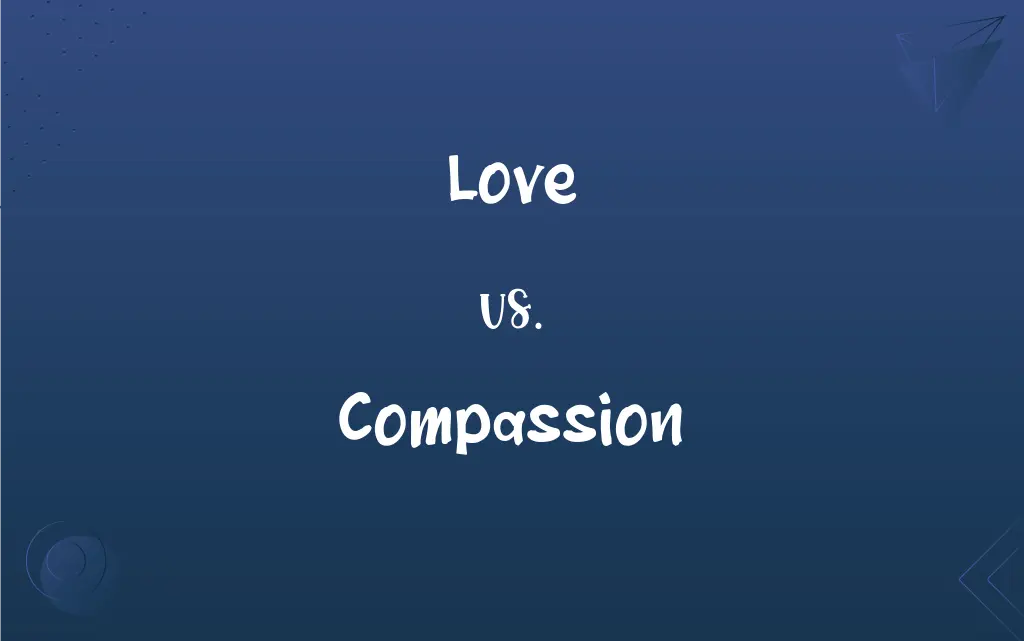Love vs. Compassion: What's the Difference?
By Aimie Carlson & Janet White || Published on March 16, 2024
Love is a deep emotional attachment, often with a focus on a specific person or entity, while compassion is a sympathetic concern for the suffering or well-being of others, regardless of their relationship to oneself.

Key Differences
ove is a multifaceted emotion that can manifest in various forms such as romantic love, familial love, or platonic love, each with its unique intensity and expression. It often involves a deep, personal attachment and a strong desire for the presence or well-being of the object of love. Compassion, on the other hand, is specifically oriented towards empathy and altruism, driven by an understanding of another's suffering and an earnest desire to help alleviate that suffering. It does not require a pre-existing relationship or emotional bond.
Love can be passionate and encompassing, involving a complex mix of emotions, commitments, and actions towards someone or something, compassion is more about the emotional response to another's pain and the motivation to help. Compassion can be a component of love but stands out for its focus on concern for others' welfare beyond one's own personal gain or emotional fulfillment.
Love often leads to actions aimed at creating happiness or fostering the relationship, driven by both emotional and sometimes physical attraction. Compassion motivates actions primarily aimed at relieving suffering, without necessarily seeking personal happiness or relationship enhancement. This distinction highlights the different motivations and outcomes associated with each feeling.
The experience of love can deeply affect one's happiness, sense of purpose, and emotional state, often linked to personal fulfillment and the joy of being with another. Compassion, while also fulfilling, is less about personal joy and more about the altruistic aspect of human nature, focusing on the well-being of others as an end in itself.
Compassion can exist within the framework of love, enhancing the depth and understanding in a relationship, but one can also feel compassion towards strangers or even adversaries without any element of love. This demonstrates the broader applicability of compassion across different types of relationships and interactions.
ADVERTISEMENT
Comparison Chart
Definition
Deep emotional attachment and affection.
Sympathetic awareness of others' distress.
Focus
Personal attachment, affection, or attraction.
Empathy and desire to alleviate suffering.
Motivation
Emotional fulfillment, joy, relationship building.
Altruism, helping others, relieving suffering.
Relationship
Requires some form of relationship.
Does not require a pre-existing relationship.
Outcome
Personal and mutual happiness, bonding.
Alleviation of others' suffering, welfare improvement.
ADVERTISEMENT
Love and Compassion Definitions
Love
Romantic love.
She felt a deep romantic love for her partner, dreaming about their future together.
Compassion
Global compassion.
He participated in international aid efforts, driven by a sense of global compassion.
Love
Unconditional love.
Parents often feel an unconditional love for their children, accepting them flaws and all.
Compassion
Empathetic compassion.
Seeing the homeless man shivering, she felt empathetic compassion and offered her scarf.
Love
Platonic love.
They shared a platonic love that was deep and enduring, supporting each other through life's challenges.
Compassion
Self-compassion.
He practiced self-compassion by forgiving himself for past mistakes and focusing on his wellbeing.
Love
Self-love.
Embracing self-love, she took time for self-care and personal growth.
Compassion
Compassionate action.
Her compassionate action involved volunteering at the local shelter every weekend.
Love
Familial love.
His familial love for his siblings was evident in his protective nature.
Compassion
Compassionate listening.
She offered compassionate listening to her friend, providing comfort without judgment.
Compassion
Deep awareness of the suffering of another accompanied by the wish to relieve it.
Compassion
Deep awareness of the suffering of another, coupled with the wish to relieve it.
Compassion
(obsolete) To pity.
Compassion
Literally, suffering with another; a sensation of sorrow excited by the distress or misfortunes of another; pity; commiseration.
Womanly ingenuity set to work by womanly compassion.
Compassion
To pity.
Compassion
A deep awareness of and sympathy for another's suffering
Compassion
The humane quality of understanding the suffering of others and wanting to do something about it
FAQs
What is the main difference between love and compassion?
Love is an intense emotional attachment, while compassion is a desire to alleviate others' suffering.
How do love and compassion affect relationships?
Love deepens personal relationships through emotional bonds, while compassion fosters understanding and support.
Can love exist without compassion?
While love often includes compassion, it's theoretically possible to have love without the altruistic aspect of compassion.
Are love and compassion emotions or actions?
They are both. Love and compassion encompass feelings as well as the actions they motivate.
How can compassion improve a loving relationship?
Compassion can enhance a loving relationship by adding a layer of empathy and understanding towards each other's experiences.
Why is compassion important in times of crisis?
In times of crisis, compassion is crucial as it drives people to support each other, alleviating pain and suffering through collective action and empathy.
How does expressing love differ from expressing compassion?
Expressing love often involves personal gestures that signify deep affection or attachment, while expressing compassion focuses on understanding and addressing another's pain or needs.
Is compassion always part of love?
Compassion enhances love but is not a mandatory component of all forms of love.
Can you feel compassion for someone you don't love?
Yes, compassion can be felt towards anyone, including strangers, without needing a personal attachment.
Is self-love the same as self-compassion?
Self-love focuses on overall affection for oneself, while self-compassion specifically addresses being kind to oneself in times of failure or suffering.
Is compassion a value that can be taught?
Yes, compassion is a value that can be cultivated and taught through empathy, ethical education, and exposure to diverse life experiences.
Can compassion lead to love?
Compassion can sometimes grow into love, especially if it deepens the connection and understanding between individuals.
Can animals experience love and compassion?
Animals can show behaviors suggestive of love and compassion, such as bonding, comforting, and protecting others, indicating emotional capacities similar to humans.
How can one develop more compassion?
Developing more compassion involves practicing empathy, engaging in acts of kindness, and putting oneself in others' shoes to understand their perspectives and hardships.
What is the role of compassion in leadership?
In leadership, compassion fosters a supportive and understanding environment, encouraging collaboration, morale, and a sense of community among team members.
How do love and compassion contribute to personal growth?
Love and compassion contribute to personal growth by encouraging individuals to form deeper connections, practice empathy, and adopt a more altruistic outlook towards life and relationships.
What role does compassion play in society?
Compassion fosters empathy and altruism, contributing to societal welfare by encouraging actions aimed at helping others.
How do cultural differences impact the expression of love and compassion?
Cultural differences can shape the ways love and compassion are expressed and valued, with varying norms and practices highlighting different aspects of these emotions.
What psychological benefits do love and compassion offer?
Both love and compassion can offer psychological benefits, including reduced stress, increased happiness, and a sense of belonging and purpose.
Is there a limit to love and compassion?
While theoretically boundless, practical limits to love and compassion can arise due to personal capacities, societal norms, and individual circumstances, but expanding these limits is often possible through conscious effort and practice.
About Author
Written by
Aimie CarlsonAimie Carlson, holding a master's degree in English literature, is a fervent English language enthusiast. She lends her writing talents to Difference Wiki, a prominent website that specializes in comparisons, offering readers insightful analyses that both captivate and inform.
Co-written by
Janet WhiteJanet White has been an esteemed writer and blogger for Difference Wiki. Holding a Master's degree in Science and Medical Journalism from the prestigious Boston University, she has consistently demonstrated her expertise and passion for her field. When she's not immersed in her work, Janet relishes her time exercising, delving into a good book, and cherishing moments with friends and family.































































